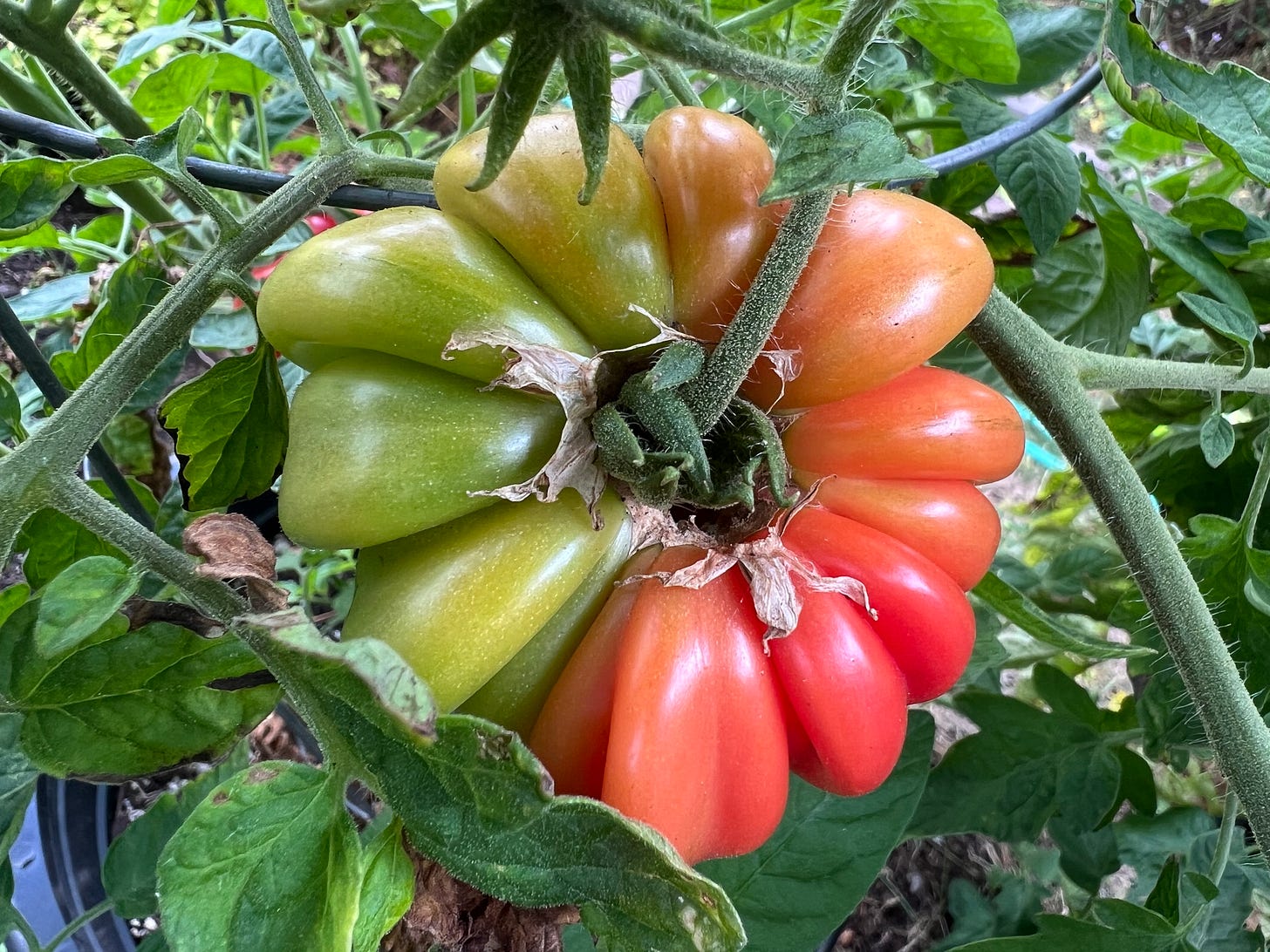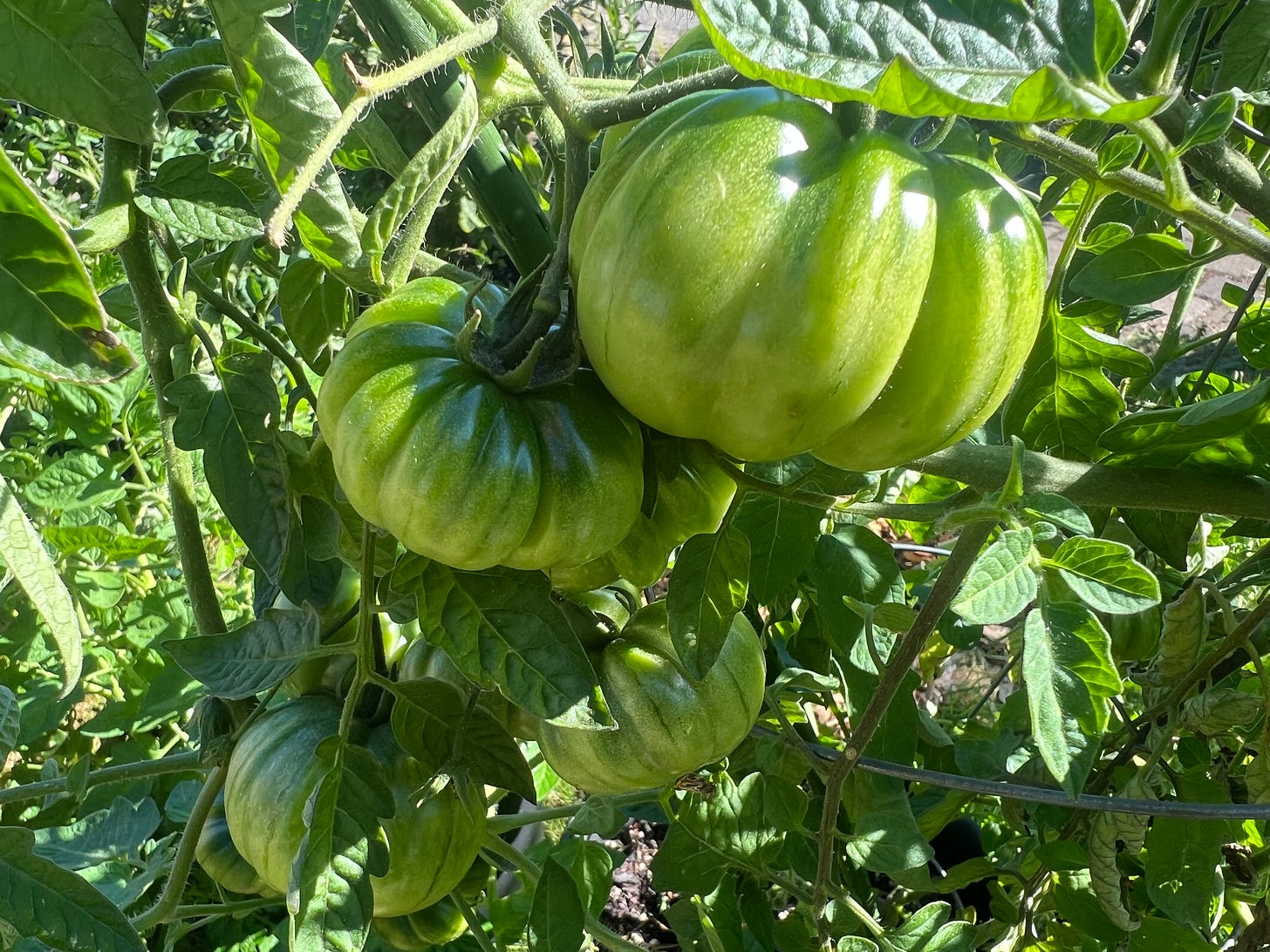Growing the perfect tomato
Growing up, both my grandfather and my father tended vegetable gardens. I remember picking enough pole beans with my dad to fill our chest freezer with pint-sized bags that we would defrost for dinners through the winter (by March, freezer burnt green beans were my least favorite side dish). One of my most vivid childhood memories is biting into a fresh, sun-warmed tomato in my grandparent’s front yard. I remember the primal feel of picking the fruit myself and eating it unwashed. The juice bursting out of my mouth and the taste of sweet earth and salty labor all rolled together. The smell of tomato vines lingering on my hands. When asked to imagine childhood joy, this memory comes to mind.
Now with a modest vegetable garden of my own, I head to my local nursery as soon as daffodils signal the arrival of spring to pick out seeds–typically tomatoes, zucchini, pumpkins, and maybe some green onions or carrots. I usually then make a second trip back to the nursery a few months later to buy plant starts when my sprouts either died or the seed packets were pushed out of sight and forgotten behind jars on the kitchen counter. By fall, I’ve coaxed enough vegetables out of the ground for a few meals, a perfectly suited reward for my half-hearted tending. And for the most part I’m very happy with this arrangement, except for my tomatoes. By late September when Seattle skies turn cold and gray, I’m often left with dozens of small green tomatoes that are more likely to mold on the vine than they are to ripen.
This past winter, I found myself facing many transitions all at once - changes in career and lifestyle, grief following the death of loved ones, and celebrating a milestone birthday. I found myself subconsciously looking for an anchor. Something tangible I could go back to and touch to keep me grounded amidst the change. A through-line to connect my past, present, and future.
Then one day an idea came to me - to try to grow perfect tomatoes. I had plenty of time to plan and tend the plants, and with an early start and the likelihood of a warm summer this could be the ideal year. I could draw upon past joy while planting seeds of intention for the future.
If I was going to do this properly, I needed to buy high-quality heirloom seeds and follow expert advice regarding the importance of growing zones, taste profile, ripening time, etc. I ordered the Baker’s Creek seed catalog and the day it arrived quickly turned to the tomato section where I found an overwhelming 60 varieties. I never got past the second photo, labeled: “Mushroom Basket” #TK164. The description read: “A favorite variety, introduced from Russia. One of the most beautiful and attractive tomatoes we have ever grown. It is very ribbed and pleated, but otherwise uniform, large, and perfect looking. The flavor is sweet, mild, and good; flesh is firm and the seeds are very few.”
This tomato was meant for me. After all, my husband studies mushrooms and I recently learned that my grandfather’s German ancestors emigrated to America by way of a multi-generational stop in Russia. Furthermore, #TK164 was reported to have a 75-day ripening timeline instead of the more standard 80 days. Those five extra days could be the difference between deep red, soft, delicious tomatoes, and the hard, green, not-even-good-when-fried tomatoes I’m all too familiar with. It was serendipity.
In late March, I planted my full packet of Mushroom Basket #TK164 in small, plastic containers filled with dark potting soil. After almost two weeks of being warmed, watered, and lovingly watched, the first leaves popped up. Second and third sets of leaves soon followed, and by late April I had a healthy crop of fragile tomato seedlings. So many seeds had germinated that I would soon have to “thin” them - pulling some of the seedlings to give room for the strongest to grow. This was the first point in the process when I doubted myself. Picking the variety of seeds was one thing, but deciding which tiny plants should live and which should die was quite another. I realized that I played a pivotal role in the life of these plants - I wasn’t just an observer, leaving their fate up to chance. If I was determined to help them thrive, I had to be fully invested. And being invested meant I could make mistakes.
By early May the remaining plants, the chosen ones, were full of vigor. I started taking the seedling trays outside for a short daily “recess” to expose them to the realities of the world that they’ll soon be living in - a world without controlled lights, reliable warmth, and protection. In June the tomatoes had fully graduated outdoors. I watered them diligently. They continued growing, with stalks looking strong and starting to fill out their wire cages. Tiny yellow flowers appeared. July arrived along with small, beautiful little green fruit, shiny and round like painted glass balls on a Christmas tree. It was turning out to be an especially dry and warm summer. Everything was going according to plan and I settled into a contented feeling that if I just followed this through, everything would turn out well.
Then on a Tuesday morning in late July I went outside to water the tomatoes and saw a brown spot on the bottom of the biggest, most beautiful tomato of the bunch. I gently turned it to look closer and the spot was bigger than I’d originally thought - like the bottom of the tomato had been dipped in an aging spell that wrinkled the skin and turned it the color of dirt on a fresh grave. I touched it gently and my finger sunk into the brown, rotten flesh.
I embraced denial. It must just be a fluke. The rest of the tomatoes would certainly be fine. I picked the tomato and tossed it in the compost bin, pushing it deep into the dark of my consciousness as the lid closed. After all, this wasn’t the anchor I was looking for. I was craving the carefree joy of childhood, not the adult reality of death and decay.
Two days later I saw another brown spot, and forced myself back into responsible adulthood. I looked up the symptoms and learned my tomatoes most likely suffered from blossom-end rot, a condition that occurs when the plant is deficient in calcium. The calcium deficiency could be from one of many factors - improper watering, not enough fertilizer, too much fertilizer, or even high salt levels. The good news was that it could be treated, the bad news was that I had to decide which of the potential causes was likely the culprit, knowing the wrong choice could exacerbate the problem. So like with deciding which seedlings to cull months earlier, I made my best guess and hoped it was the right one, connecting the fate of these tomatoes even more closely to my own actions. I’ll never know whether it was due to luck or my decision to add more fertilizer, but no other brown spots appeared.
By mid-August, well before the end of summer, my first tomatoes were ready for harvest. While most of the small tomatoes were still green, one plant had produced four (four!) beautiful, bright red, sun-warmed, soft to the touch, perfectly ripe tomatoes. They were attractive; ribbed and pleated, and a nice size. Just as the Baker Creek catalog promised.
I gently plucked two of the ripe tomatoes and cradled one in each hand as I walked straight into the house and placed them on the cutting board. Without even a rinse in the sink I sliced them open, pleased to see the bright red color consistent throughout the fruit. I tried to maintain a casual facade as my excitement built and my heart beat faster. I was ready for the reward from my hard work. Ready to be transported back to that feeling of childhood bliss.
I bit in, chewed, and swallowed. I took another bite and chewed more slowly this time. And it was…fine.
I want to write that it bursted with flavor. I want to say that it was the best tomato that I’ve ever had. That childhood joy came rushing back through my taste buds and expanded into a burst of light - a light that said everything was good and always would be. I even briefly tried to lie to myself and pretend that was true. But no, the tomato was not perfectly delicious. The texture was just a little too soft. The taste was a bit muted. It was just fine.
I retreated back into my feigned casualness, nonchalantly going about my way in the kitchen while deep inside the shadows of self-doubt and shame crept in. What did I do wrong? Did I water too much or not enough? Did the tomatoes need more fertilizer? Or less? Why was everyone else’s mushroom basket tomato the perfect mix of sweetness, beauty, and nostalgia? Why did I fail? Why was I a failure?
Yes, that’s an extreme reaction to a tomato. I am aware. No 40-year-old, successful, grown ass woman should consider herself a failure because of a bland tomato. But the pain was real. I was flooded with grief at the loss of this idea - this anchor that would ensure my safety as I navigated open waters. That no matter where the next phase of life took me, I could always tap back into the pure joy and love of a summer tomato.
A few hours later I was back in the yard, just as daylight was fading and a slight chill settled in the air. I watered and carefully eyed my remaining tomatoes. First with a bit of sadness. I found myself caressing the leaves of one vine as if sharing a moment of tenderness with the plants as we both grieved. But as I looked at the imperfect plants, I saw they were still beautiful. Then the smell of the vines reached my nose and for a moment I was right back in the gardens of my childhood. I smiled as that feeling of carefree joy tickled the edges of my heart. Back in the present, I remembered the pride I felt just a few days earlier when the first of this year’s tomatoes turned red. I had dragged my husband outside to show them off, and he had dutifully agreed they were amazing. I had even sent a picture to my family, nestled in our text thread between updates from my mom regarding the health of my 91 year-old grandfather and funny anecdotes from my sister on her two children.
I let go of my grief at not growing the perfect tomato, as that had really never been my goal. The anchor, the connection I was looking for, was already and always would be inside of me. I just needed to tap into it. My mushroom basket tomatoes were just doing the best they could with the world they were born into, like me. And that is beautiful.
Will I try to grow tomatoes again next year? I imagine so. But maybe I’ll go back to the Baker’s Creek catalog to find a more suitable variety. Like this one on the next page: #TP114 - Brandywine. I love brandy and I love wine. What could go wrong?











